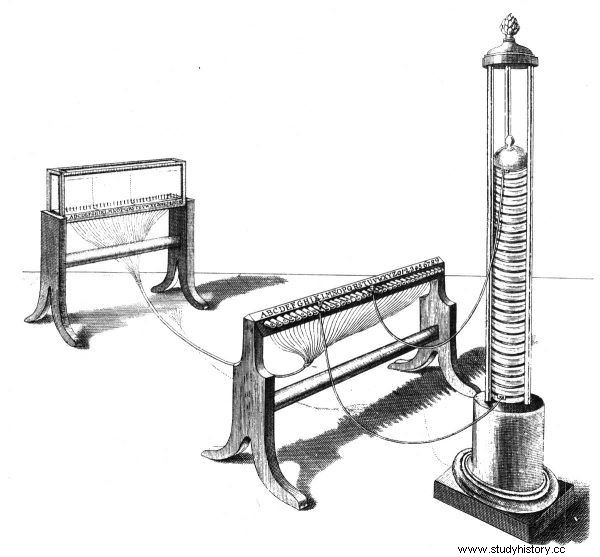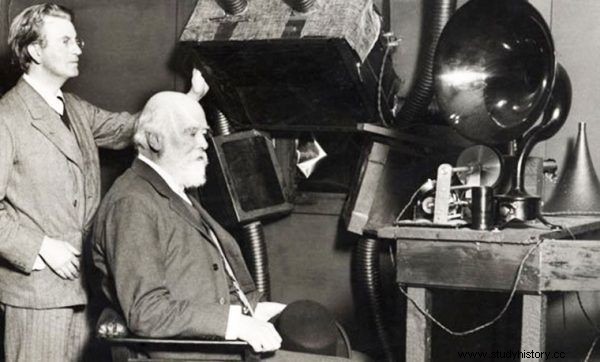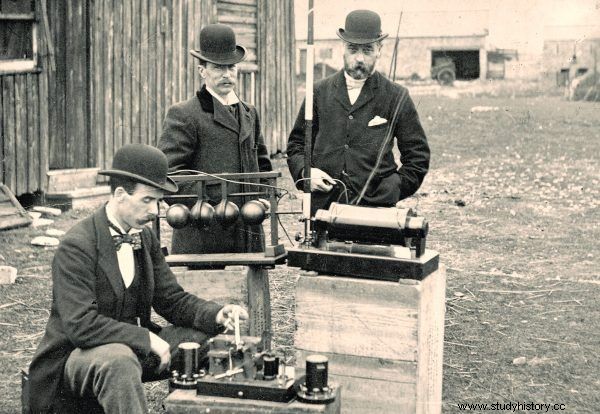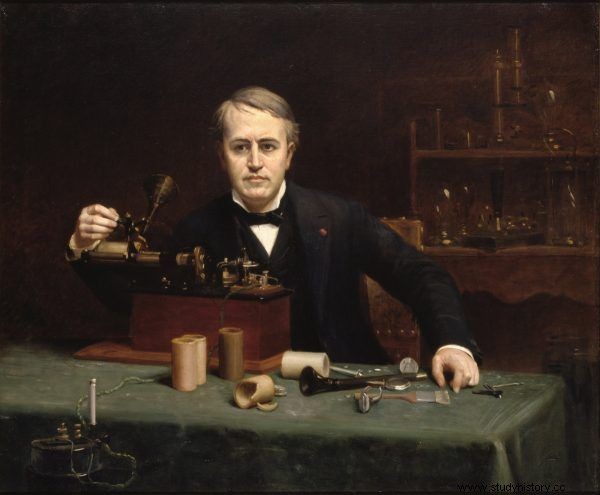It is a common belief that great 19th-century inventions were born suddenly, as a result of an enlightenment experienced by one genius. Edison, Morse and Marconi are heroes of the collective imagination. It's time to remind you that their successes had many fathers, and not the wisest, but ... the most cynical and understanding the rules of PR passed down history. Who were the others then?
The telegraph became associated in the collective consciousness with the name of Samuel Morse. In fact, the history of electric remote communication goes much deeper into the past. The situation is similar with the light bulb, commonly associated with Thomas Edison.
On the other hand, the radio, the invention of which is attributed to several different people, most often Guglielm Marconi, to this day is the cause of heated discussions among supporters of individual versions of events.
An electrifying experiment
In 1746, 180 Louis XV guards stood in the Mirror Gallery of the Palace of Versailles, holding hands in the presence of the king and the court. This unusual event was part of an experiment conducted by Jean-Antoine Nollet. The aim of the scientist was to estimate the speed of electric charges.

The Mirror Gallery in Versailles - a setting worthy of groundbreaking scientific experiments. Did it ease the pain of the soldiers used as guinea pigs? (photo:Myrabella, CC BY-SA 3.0).
To this end, he electrocuted the hapless soldiers . When one of them touched the electrode of the Leiden bottle (a kind of primitive capacitor), they all simultaneously experienced an electric shock. This meant that the electricity traveled fast enough that the human senses would not be able to perceive any delay.
Nollet's experience started a long series of work on the use of electricity to transmit information. The proposal to construct an electrostatic telegraph was first presented in the middle of the 18th century , in 1753 in the Edinburgh Scots Magazine.
According to the concept presented by an anonymous author, the electric charges were to be carried by wires to the receiving station, causing the attraction of pieces of paper with letters on it. Until the end of the century, several attempts were made to build such a device, but the technical means available at that time did not allow for the construction of a functional telegraph.
Message in the aquarium
The situation improved after the invention of the primitive galvanic cell by Alessandro Volta in 1800. The device generated a strong electric current that could be transmitted through cables over long distances. However, there were still no instruments that would allow a convenient way to read the message encoded in electrical impulses.

Samuel Thomas von Sömmerring's telegraph (pic:public domain).
In 1809, Samuel Thomas Sömmerring demonstrated a telegraph that used water electrolysis for this purpose. His camera was in the form of a glass aquarium in which a set of electrodes with assigned letters of the alphabet was immersed. Hydrogen bubbles formed around the electrode under the influence of electricity.
However, this system was not suitable for practical use , mainly due to the need to run a separate wire for each letter, which increased the cost of building the line.
Magnetic needle
The breakthrough came in 1820, when the Danish physicist Hans Christian Ørsted observed the deviation of a magnetic needle placed near a conductor through which a current was flowing. In 1832, this discovery inspired Paweł Shilling, a diplomat serving at the Russian embassy in Munich.
The inventor built a telegraph that transmitted a message encoded in the movements of a magnetic needle. A year later, Carl Friedrich Gauss and Wilhelm Weber experimented with a similar device in Göttingen.
In 1837, the design of the telegraph was refined by the English:William Cooke and Charles Wheatstone. They used a set of five magnetic needles placed on a diamond-shaped dial marked with the letters of the alphabet. A switch set made it possible to manipulate a pair of needles on the other side of a line to point to a specific letter.
It was the first telegraph to find commercial use. It was used in 1838 to handle rail traffic between Paddington and West Drayton stations. The biggest disadvantage of the device was the necessity to connect the stations with as many as six wires.

The telegraph of William Fothergill Cooke and Charles Wheatstone (photo:Geni, CC BY-SA 4.0).
Samuel Morse's telegraph, developed at the same time on the other side of the Atlantic, was devoid of this disadvantage. The camera needed only two wires, but it was paid for with much more difficult operation. The operator had to know a special alphabet made up of dots and dashes drawn on paper tape.
On the airwaves
The existence of electromagnetic waves was predicted by James Clerk Maxwell in the mid-1860s. In November 1886, they were finally confirmed by an experiment carried out by Heinrich Hertz, a 25-year-old physicist at the Karlsruhe University of Technology.
The transmitting apparatus used had a small range, and the instrument used to detect the waves was far from perfect, so the scientist saw no practical application for his discovery . Its success, however, caused a stir in the world of science, and numerous followers began their own experiments in this field. Hertz himself did not live to see the technical revolution he initiated - he died prematurely in 1894.
Success had many fathers
A few months later, the waves discovered by the German were used for the first time to send a telegraph message. This was done by the English physicist, Sir Oliver Lodge, in one of his lectures at the British Association.
This was possible thanks to an improved version of the coherer - a sensitive wave detector, developed four years earlier by Édouard Branly. Lodge failed to see the financial potential of its apparatus and failed to apply for a patent on time. He was primarily a scientist, not an entrepreneur.

Oliver Lodge (right) during the first radio telegraph transmission (photo:public domain).
In Russia, the coherera was used by Alexander Popov, who built in 1895 a device designed to receive waves generated by lightning discharges. The approaching storm triggered an electric bell installed in the researcher's studio. In the following years, Popov worked on transmitting telegraphic messages by radio.
At the same time, in the United States, Nikola Tesla was experimenting with radio communication and the technique of high-frequency currents. These works were of fundamental importance for the later development of radio technology. In 1898, a great deal of excitement was made by Tesla's presentation of a remote-controlled boat model.
The name of the inventor of the radio is often mistakenly attributed to the Italian Guglielmo Marconi. He began his experiments at the turn of 1894 and 1895 as a physics student at the University of Bologna. The apparatus he used consisted of the same elements that they used before, among others Hertz and Lodge.

British post office officials check Marconi's radiotelegraph (Photo:Cardiff Council Flat Holm Project, CC BY 3.0).
Marconi managed to increase the communication range so much that it became possible to use the radio telegraph commercially. In 1896, the young inventor left for Great Britain, where he obtained a patent for his device. A year later, the Wireless Telegrach and Signal Company was founded, and the benefits offered by the new invention were noticed by the British Navy, which ultimately ensured Marconi's success.
The origins of electric light
The idea of using electricity to illuminate rooms appeared at the beginning of the 19th century. Physicist Humphry Davy demonstrated a method of generating a bright electric arc "burning" between two electrodes.

Satirical drawing of one of Humphry Davy's lectures (etching by James Gillray, Wellcome Library, no. 544797i, CC BY 4.0).
From the 1840s, attempts were made to construct a lamp based on this phenomenon, with only partial successes. The generated light was bright and quickly tired the eyes, so it was not suitable for lighting rooms . In addition, the electrodes burned out in just a few hours and had to be replaced.
Another concept has also been experimented with. Cables made of certain materials were known to glow when exposed to electric current. Building a functional light bulb required finding a substance that shines bright enough without burning out immediately.

Thomas Alva Edison in the portrait of Abraham Archibald Anderson (public domain).
Due to the high temperature, the filament wire had to be protected against oxidation by placing it in a glass bulb devoid of air or filled with neutral gas. One of the first experiments in this field was carried out in 1840 by British William Grove.
The problem of the light bulb interested scientists for the next four decades, only in 1878 it was solved independently by the Englishman Joseph Swan and the American Thomas Edison . This led to several years of struggle for patent rights, ultimately ending in 1883 with an agreement and establishing cooperation between them.
Termination
Most of the inventions in history were created thanks to the involvement of many people. They included both physicists discovering the laws governing the universe, engineers constructing new devices or their components, as well as entrepreneurs responsible for the market success of new technical solutions. Elon Musk, sometimes referred to as "the new Edison", belongs to the latter category today.
Popular discourse often exaggerates the achievements of some of these people and completely ignores others. Sometimes it is motivated by political reasons or national pride. It is worth remembering, however, that reality is usually much more complicated, and success - as it usually happens - has many fathers.
Inspiration:
This article was inspired by Ashlee Vance's book Elon Musk. Biography of the creator of PayPal, Tesla, SpaceX (Horizon 2016 sign).
Bibliography:
- Ken Beauchamp, History of telegraphy , Institution of Electrical Engineers, London 2001.
- Andrzej Kajetan Wróblewski, History of Physics. From the earliest times to the present day , PWN, Warsaw 2009.
- Bolesław Orłowski, The Universal History of Technology , Ed. Talking Wieki, Warsaw 2010.
- Tom Standage, The Victorian Internet. The remarkable story of the telegraph and the nineteenth century's online pioneers , Walker and Co., New York 1998.
